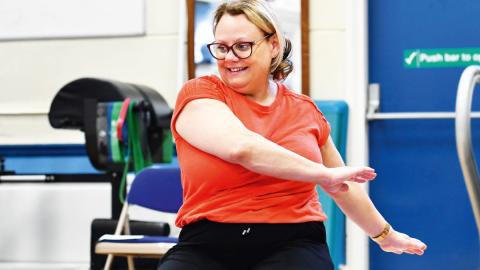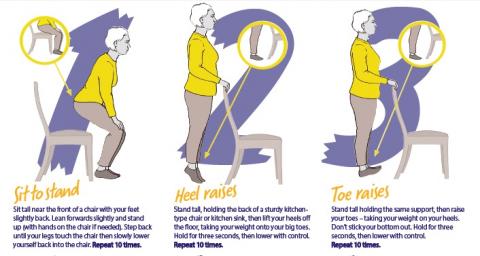This report shares an overview of the insight and recommendations for strength messaging from people living with long term health conditions aged 39-64 and physiotherapy staff in the UK from a range of clinical specialities and grades.
Background
Maintaining and improving muscle strength is crucial to help people live independently as they age and empower them to manage long-term health conditions.
But as of late 2019, too few people with long-term conditions (LTCs) did strengthening on a regular basis, and too little was known about how they could be supported to increase that participation.
Responding to these gaps, the CSP was commissioned by Sport England and the Centre for Better Ageing to tackle the issue.
Project aims and objectives
What were the aims of the project?
- Create a learning legacy for messaging that best engages our target audience in strengthening activities
- Identify the opportunities that exist to scale up support from physiotherapy staff and allied health professionals and support the need to enable behaviour change.
What were the project objectives?
- Improve the insight around effective strength messaging for inactive and fairly active people living with LTCs aged 39-64 years.
- Identify how physio staff can raise awareness, promote strengthening and support their patients through the behaviour change journey and identify what is needed to achieve this.
- Create shareable recommendations on the concepts and messages that are most likely to work, and who within the target audience they are most effective at influencing.
- Determine the size and scale of opportunity to increase awareness and change behaviour amongst the target audience via physiotherapy staff.
- Develop recommendations for phase 2: which messages/concepts go the widest and should be developed and scaled up in real world settings, how and by who.
[Strengthening] helps maintain function and mitigates against loss of muscle mass and bone density.
Exploratory research
We started working with BritainThinks in January 2020. We gathered insight from published research, stakeholders, our member survey and focus groups to understand more about our members’ experiences of talking about strength.
We sought crucial perspectives from people living with LTCs through online diaries, in depth interviews and focus groups to understand more about their experiences, what motivates them and their barriers.
Key insights and motivations
Key insights from people with LTCs
- There is no ‘typical’ inactive person with a long-term condition: this is a highly diverse audience both in terms of the nature and impact of health condition and also in terms of mindset, experiences of physical activity, demographics and lifestyle.
- The concept of strengthening activity is much less front-of-mind than cardiovascular exercise / physical activity more broadly, while baseline awareness and understanding of strengthening guidance is very limited.
- There is considerable potential for confusion when providing strengthening guidance and a risk of conflation with moderate physical activity more broadly, with the CMO/NHS guidelines perceived to be vague and unhelpful.
- There is some underlying desire to do more general physical activity and interest in understanding more about strengthening activity – suggesting some potential motivation to change behaviour for the CSP initiative to tap into.
- Short-term benefits of strengthening related to ‘doing more’ (e.g. ability to complete daily activities) and ‘feeling better’ (e.g. managing the condition, improved mood or self-esteem) tend to be more motivating than longer-term medical benefits.
- In addition to low awareness and understanding of strengthening activity, a perception that their condition inhibits activity or would deteriorate as a result is widespread – though there is a wide range of additional barriers faced by this audience.
Motivations for people with LTCs
- There is only a vague awareness of the benefits of strengthening
- Initially, most simply articulate the benefits of strengthening simply as “exercise is good for you” but on deeper consideration, many can think of more specific benefits – but these are generally applicable to any physical activity:
- “Getting stronger”
- “Feeling a sense of accomplishment”
- “Cheering you up”
Key insights from physiotherapy staff
- Physio staff all strongly believe strengthening to be important, have a detailed understanding of the benefits and claim to frequently provide strengthening advice to patients. They are likely to be willing messengers for the initiative.
- Knowledge of the CMO strengthening guidelines is only mixed and there is considerable criticism of them in terms of how useful, clear and instructive they are. This means that they are rarely used in practice when providing guidance.
- Instead, the strengthening advice that physio staff provide varies considerably. Some of this is due to a requirement to be patient-specific – but there is also significant inconsistency in terms of motivating message and supplementary resources.
- Physio staff – particularly NHS staff – perceive a number of challenges to providing strengthening advice, including low patient understanding and motivation, lack of time in patient contact, lack of resources and contradictory advice from other HCPs.
- Most physio staff have a good understanding of the motivations and barriers faced by the target group – but can underestimate softer, more emotional motivators (e.g. body image, self-esteem) and barriers (e.g. embarrassment, low mood).
- Physio staff are often narrowly associated with short-term treatment of injury and recovery, with patients not looking to them for longer-term health, lifestyle and behavioural advice.
Recommendations
- Make messaging relatable
- Provide tailored guidance
- Set a specific, memorable target
- Raise widespread awareness
- Ensure inclusivity and accessibility
- HCPs, friends and family, and informal online networks are viewed as key sources of advice on health and lifestyle.
Pre-creative testing
As the Covid-19 pandemic developedwe recognised the need to explore the impact of lockdown on our target audience and, to help enhance the findings from the insight, test some ‘rough’ draft stimulus. This included testing of visuals, tone and narrative.
In May 2020 we carried out this ‘pre-creative testing’ phase,using online methods and telephone interviews to ensure the project remained on track and on time.
Key considerations
- Make inclusivity and relevance explicit
- Avoid negatives and focus on positives
- Remind of the (future) benefits
- Avoid references to ‘pain’ or ‘tiredness’
- Use the notion of starting small and improving
- Offer a range of options for strengthening
- Avoid use of ‘technical’ language
- Use a target but ensure it is realistic and flexible
Creative development
Five possible creative routes were developed with different conceptual approaches to support the initiative.
Creative routes
Recommendations
- Choose between ‘Better with strength’ and ‘Stronger My Way’ to take forward – but incorporate the best of both.
- Select the lead visual very carefully to ensure it is engaging, relevant and clear.
- Balance the need for tailoring with a lack of expertise and confidence.
- Explain how strengthening activity can be done.
- Reassure physiotherapy staff that they will have control over the process.
- Signpost to further resources to achieve behaviour change.
Strength messaging dos and don'ts
Do…
- Say ‘gradually increase’
- Say both ‘maintaining’ and ‘improving’ strength
- Use everyday, simple language (e.g. raising your leg)
- Convey that strengthening is easy
- Provide a target and show strengthening is accessible (i.e. at home, with everyday items)
- Talk about choosing from ‘approved’ exercises
- Refer explicitly to strengthening and to the audience having health conditions
Don’t…
- Say ‘gently increase’
- Only say ‘maintaining’ or ‘improving’ strength
- Use words seen as jargon/technical (e.g. calf raises)
- Explicitly say strengthening is easy
- Use unnecessarily patronising terms (e.g. lifting ‘small’ bottles)
- Ask the audience to ‘design’ a programme of strengthening
- Be vague about the target audience or message
Concept development
We tested tested two concepts:
- A tailored, progressive strengthening programme that builds towards achieving a meaningful, quality-of-life goal set by the patient and supported by physiotherapy staff.
- A communications campaign to encourage strengthening that’s based around informative, inspiring resources that physiotherapy staff can use to support their conversations with patients.
Resources
We asked which resources would be most useful to support physios personally in encouraging people with long-term conditions to undertake strengthening activity more regularly. Their answers are below:
The most popular resources were training for physios and tools that patients could engage withindependently.
Key insights
- The Covid-19 pandemic has made the need for strengthening more important (due to deconditioning and restricted access to medical support) – but has also made it harder for physios to test patients’ strength and encourage them to do more strengthening.
- Of the two concepts, there was an overwhelming preference for Option 1 – the strengthening programme: physios felt giving patients a personal quality-of-life goal would be motivating, while giving physios a clear role in helping patients achieve this goal was seen to more effectively drive behaviour change.
- Option 2 – the communications campaign – was felt to fill an important gap in public health messaging about strengthening – but there were concerns about whether it would effectively cut through to the target audience and inspire genuine change.
- All of the supporting resources tested were popular, though physios particularly liked motivational training and guidance on how to talk about strengthening with patients facing challenges.
- Physios felt that any intervention should feature an online hub as a one-stop-shop for the different resources, whilst including offline alternatives for patients with lower digital access.
Putting it into practice
In December 2020, we allocated budget to support the development of the leading concept, Stronger My Way.
MOVE Consulting, specialists in behaviour change, are working with a steering group of physiotherapy staff from all parts of the profession to understand the real world application of the project’s learning.
This partnership will identify and test products and tools that support engagement and adherence in strength-based activities for their patients.
Outcomes
The outcomes sought from this phase are:
- Identify design characteristics for a strength-based behaviour change product/tool.
- Highlight good practice / tools utilised in existing programmes and campaigns.
- Co-design strength advice, targeting physiotherapy staff across multiple settings.
- Identify, co-develop and test resources and tools to support delivery of strength advice.
- Provide a project report, detailing ‘proof of concept’ for influencing practitioner behaviour.
- Create ‘Phase Two’ recommendations to support scalability of the project.
The findings of this phase will be presented in late April.
If [the online hub] is a slick system, you can use it to prescribe exercises in clinic. You go on the website, instead of giving them a leaflet or videoing them.
Next steps
Our vision is to convert all of the learnings into a concise creative brief that can take us to a national activation of Stronger My Way.
We want to work with partners to develop those plans and support a sustainable rollout and we want to create a legacy for this project that empowers people with long-term conditions to get stronger, their way.



